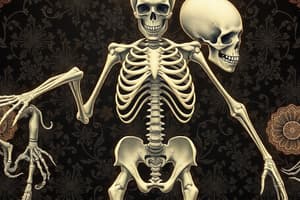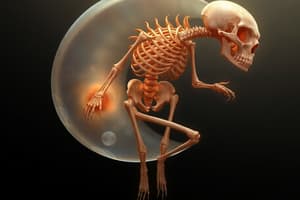Podcast
Questions and Answers
Which condition is characterized by the failure of bone growth inherited as a dominant trait?
Which condition is characterized by the failure of bone growth inherited as a dominant trait?
- Syndactyly
- Pectus excavatum
- Achondroplasia (correct)
- Polydactyly
What is the most common congenital deformity of the anterior chest?
What is the most common congenital deformity of the anterior chest?
- Syndactyly
- Polydactyly
- Pectus carinatum
- Pectus excavatum (correct)
Which skeletal condition results in the sternum being displaced anteriorly?
Which skeletal condition results in the sternum being displaced anteriorly?
- Polydactyly
- Syndactyly
- Pectus carinatum (correct)
- Achondroplasia
What is the incidence rate of clubfoot among children?
What is the incidence rate of clubfoot among children?
Which condition involves the fusion of two fingers or toes?
Which condition involves the fusion of two fingers or toes?
What physical feature characterizes achondroplasia in children?
What physical feature characterizes achondroplasia in children?
What is the cause of developmental dysplasia of the hip (DDH)?
What is the cause of developmental dysplasia of the hip (DDH)?
In the context of torticollis, what is the primary treatment for a newborn with a wry neck?
In the context of torticollis, what is the primary treatment for a newborn with a wry neck?
What is the consequence of premature closure of the sagittal suture line in craniosynostosis?
What is the consequence of premature closure of the sagittal suture line in craniosynostosis?
Which condition involves the foot being in a plantar flexion position and the forefoot lower than the heel?
Which condition involves the foot being in a plantar flexion position and the forefoot lower than the heel?
How is craniosynostosis typically diagnosed?
How is craniosynostosis typically diagnosed?
What is the primary risk factor for developmental dysplasia of the hip (DDH)?
What is the primary risk factor for developmental dysplasia of the hip (DDH)?
What is the purpose of assessing Ortolani & Barlow signs in newborns?
What is the purpose of assessing Ortolani & Barlow signs in newborns?
Why does an affected leg appear slightly shorter than the other in DDH?
Why does an affected leg appear slightly shorter than the other in DDH?
What congenital anomaly is characterized by a tight lingual frenulum causing restricted tongue mobility?
What congenital anomaly is characterized by a tight lingual frenulum causing restricted tongue mobility?
What action can be taken during the newborn period to address ankyloglossia?
What action can be taken during the newborn period to address ankyloglossia?
What percentage of clinically identified abnormalities in mild DDH resolve spontaneously without treatment in early infancy?
What percentage of clinically identified abnormalities in mild DDH resolve spontaneously without treatment in early infancy?
What complications may severe DDH cause into adulthood?
What complications may severe DDH cause into adulthood?
Flashcards are hidden until you start studying
Study Notes
Physical or Developmental Disorders of the Skeletal System
- Causes of skeletal disorders in newborns: genetic, environmental, maternal drug ingestion, virus invasion, amniotic band formation, and unknown factors.
Finger and Toe Conditions
- Polydactyly: presence of one or more additional fingers or toes.
- Achondroplasia (Chondrodystrophia): a dominant trait that causes a disorder in cartilage production in utero, resulting in a prominent forehead, flattened nose, and near-normal trunk size, but with thoracic kyphosis and lumbar lordosis of the spine.
- Syndactyly: two fingers or toes are fused, usually caused by a simple webbing.
Chest Deformations
- Pectus excavatum (funnel chest): an indentation of the lower portion of the sternum, occurring in 1 out of 500 live births, more common in boys.
- Pectus carinatum: a sternum displaced anteriorly, increasing the anteroposterior diameter of the chest, can be surgically corrected.
Talipes Disorders
- Ankle-foot disorders, also known as clubfoot, characterized by bone deformity and foot malposition with soft tissue contracture, occurring in 1 in every 1000 children, more common in boys.
- Types of talipes disorders: pectus carinatum, torticollis (wry neck), and talipes equinovarus.
Talipes Equinovarus
- Characterized by plantar flexion (equinus or "horse foot position"), forefoot lower than the heel, and varus deviation (the foot turns in).
- Assessment: detection involves straightening all newborn feet to the midline, referral to a pediatric physician and orthopedist for further evaluation.
Craniosynostosis
- Premature closure of skull sutures, more common in boys, caused by dominant inheritance, rickets, calcium irregularities, or phosphate metabolism.
- Sagittal suture line closure: head tends to grow anteriorly and posteriorly.
- Coronal suture line closure: eye orbits are misshapen, leading to increased intracranial pressure and eye disorders.
Developmental Dysplasia of the Hip (DDH)
- Referred to as congenital hip dysplasia, a spectrum of abnormalities affecting the hip joint.
- Causes: unknown, may be related to polygenic inheritance, uterine position, or breech birth.
- Risk factors: family history, oligohydramnios, large birth gestational age, metatarsus adductus, and torticollis.
- Assessment: Ortolani and Barlow maneuvers to screen all infants (birth-3 months old).
Physical or Developmental Disorders of the Gastrointestinal System
Ankyloglossia (Tongue-tie)
- Congenital anomaly characterized by a tight or shortened lingual frenulum, causing restricted tongue mobility and impaired tongue function.
- Causes difficulty with breastfeeding due to difficulty with tongue mobility and ability to latch.
Thyroglossal Cysts
- An autosomal dominant trait, characterized by an irregular neck mass or lump that develops from cells and tissues left over after formation of the thyroid gland.
- Located in or around the neck midline, extending to the base of the tongue.
Orofacial Clefts: Cleft Lip and Cleft Palate
- No specific information provided.
Therapeutic Management
- Mild DDH: close monitoring, as 60% - 80% of clinically identified abnormalities and 90% of ultrasonographic abnormalities spontaneously resolve without treatment in early infancy.
- Severe DDH: may require treatment to prevent osteoarthritis of the hip in adulthood.
Studying That Suits You
Use AI to generate personalized quizzes and flashcards to suit your learning preferences.




